It seems like every week there is a new tragedy, a new attack that kills people senselessly. One of the things that got me about the Boston Marathon bombing was, was this terrorism? There are many different definitions of terrorism, but the FBI defines it as “the unlawful use of force and violence against persons or property to intimidate or coerce a government, the civilian population, or any segment thereof, in furtherance of political or social objectives”.
I really was curious about why the marathon bombing was immediately defined as a terrorist attack, but not the shooting at Oak Creek. Clearly, if the perpetrator is Muslim, it has to be terrorism, according to the media. But is terrorism exclusively the domain of Muslims? If a suspect of an attack is Muslim, does that immediately mean he/she is a terrorist? Why can’t they just be a regular lunatic, like white people are afforded to be?
I decided to get at the data on terrorism in the last 12 years to see if there were any trends that might give some insight or perspective on why terrorism happens. One of the first things I wanted to examine was the relationship between Islam and terrorism. I should point out that I’m aware that there is a difference between normal followers of a religion and the perpetrators of crimes under that religious banner.
Before I show the data, some clarification of my methods (since people complained about it before). So, I took all bombings and armed assaults from the Global Terrorism Database from 2001-2011 that met the following criteria:
- There must be evidence of an intention to coerce, intimidate, or convey some other message to a larger audience (or audiences) than the immediate victims.
- The action must be outside the context of legitimate warfare activities, i.e. the act must be outside the parameters permitted by international humanitarian law (particularly the admonition against deliberately targeting civilians or non-combatants).
Basically, the attacks cannot be associated with a war (though may be in a wartime setting), and must be with the intent to create “terror” in a broader context, not just among the victims of an attack. So, school shootings in the US and the Norway attacks are not considered terrorism, as they are more isolated acts without a deeper political motivation. Of these incidents, I counted the number of incidents and casualties that were ascribed to specific terrorist organizations (e.g. Al-Qaeda, Tamil Tigers, Eta, FARC).
I grouped terrorist organizations into groups, based upon shared ideology behind formation of that terrorist organization. These groups are defined as “Islam-related” (meaning that the terms “al-“, “Islam”, and “Mujahadeen” appeared in the name of the group), Marxist-related (the terms “Red”, “Marx”, or “Communist” appeared in the name), or Freedom Group (meaning the terms “Freedom”, “Liberation”, or “Army” appeared in the name). Obviously, there was some overlap, such as the Moro Islamic Liberation Front (who can affectionately be referred to as MILF), but the precedence of grouping went from left to right. So, MILF is an Islam-related group, not a Freedom Group, along with being a popular genre of pornography.
What’s interesting about those graphs is that there are almost as many Freedom groups as there are Islamic groups, and there is no significant difference in the number of terrorist attacks among Islamic groups, Marxist groups, and Freedom groups. However, there is a significant difference in the number of people hurt or killed in Islamic terrorist attacks compared to Marxists or Freedom group attacks. So, while Islamic groups are no more prevalent than other groups of terrorists, they are the most efficient at killing people.
Even though I artificially grouped the terrorist organizations, there were three clear major influences on forming an organization: Islam, Marxism, and Freedom. It seems unlikely that becoming Muslim, Communist, or pro-Liberty is the cause of terrorism, as these types of people exist in most countries without terrorism. So, it is more likely that some other set of factors promotes the creation of terrorists using Islam, Marxism, or Liberty as a tool for conversion.
So, what are the factors that make people Islamists, Marxists, or Revolutionaries?
Studies have shown that education or wealth are not strong predictors on whether someone becomes a terrorist. In fact, it appears that most terrorists are middle-class and well-educated, which makes sense, as there’s nothing more entitled and selfish than trying to kill people to prove a point. So, if poverty and education aren’t responsible, what promotes terrorism?
I assumed that the underlying cause of terrorism is one of personal unhappiness. People must have given up all hope to kill people to affect change rather than using non-violent means. Fortunately, the Legatum Institute, releases a yearly “Happiness” index. It scores prosperity in countries based upon 8 subcategories:
- Economy
- Entrepreneurship and Opportunity
- Governance
- Education
- Health
- Safety and Security
- Personal Freedom
- Social Capital
I wanted to see if there was any correlation between terrorism and the 8 metrics of the Legatum index, in hopes of identifying certain factors that are responsible for increased terrorism in a country. If you’re observant and wondering why the X-axis is numbered strangely, I had to plot the log of the number of attacks against the subcategory index score because the sheer number of attacks in Iraq were so much higher than any other country (~4000 in Iraq compared to an average of 70 for all other countries).
After doing this, I found that there were only two relationships that were correlative, and both of them had a negative relationship: safety and security, and personal freedom. Safety and security was a very strong relationship (p<0.01), most likely because number of terrorist attacks plays an important part in the calculation of safety and security in a country. What is interesting is that there is a slight (but significant) correlation between personal freedom and number of terrorist attacks. The more a country values freedom of choice, expression, movement, and belief, the less likely a terrorist attack will occur there. Societies that promote strong civil rights and individual freedoms have less terrorism.
So, I decided to look at the same index on a religious basis, by comparing the proportion of certain religions in a country against the Legatum Index.
Interestingly, there were extremely strong correlations (p<0.0001) when comparing a country’s Muslim population against 6 of the 8 Legatum subcategories. The other 2 categories, Social Capital and Economy, were still quite significant, but had a weaker relationship (p<0.005). It’s worth mentioning that all 8 showed a negative correlation between a country’s Muslim population and their “happiness”. It’s hard to infer causality from correlations, but if you did, one of two possibilities exist: either Islam makes societies unhappy, or unhappy societies are more likely to become Muslim.
Meanwhile, there wasn’t a strong correlation between a country’s population and percentage that are Christian, with the exception of Education (p<0.005) and Personal Freedom (p<0.0001). And there is no significant correlation to Hindu or Buddhist populations and any of the happiness scores (presumably because the numbers are so small).
I do think it’s interesting that relationships between Christianity and Islam compared to Personal Freedom go in similar, yet opposite, directions. The more personal freedom a country has, the larger the Christian population, and the smaller the Muslim population. Again, it’s unclear whether there is a causal effect of religion on the demand for personal freedoms, but it is clear that there is a strong and significant relationship between religion and personal freedoms.
Lastly, to try and get at what were the causes of terrorism, I decided to look at timelines of a few countries to try and identify potential trends that lead to terrorism. I looked at 6 countries that experienced terrorism to varying degrees and tried to identify possible causes for changes in the amounts of terrorism seen in these countries. These countries were:
- Iraq – If we compare a 12 year window prior to 2003, there were a total of 76 terrorist attacks killing 295 people, and injuring 470. After the Iraq invasion by the US in 2003, there have been 3,745 attacks that have killed and injured over 25,000 people (again, using the strictly defined criteria for terrorism I used before). Interestingly, when you look at the announcement of a planned US troop withdrawal in 2008, the number of attacks decreased.
- Sri Lanka – Since 1983, Sri Lanka has intermittently been engaged in a civil war, with a revolutionary organization (the Tamil Tigers) fighting for independence of the ethnic Tamil minority. So, identifying what is responsible for increased terrorism is difficult. One clear impetus for the observed rise in terrorism in 2004 would be the tsunami that ravaged the country. International relief was not equally distributed between the Tamils and the majority Sinhalese population, which likely aggravated tensions leading to a rise in attacks after 2004. Around 2008, the political leader of the Tamil Tiger movement, S. P. Tamilselvan, was killed, which began the dissolution of the resistance movement and led to a decrease in terrorism in the country.
- Nigeria – Nigeria had been a relatively terrorist-free country until around 2005, when the Nigerian Oil Crisis served as a powder-keg for a rise in terrorist activity. The years of unrest of an ethnically disenfranchised minority in the Nigerian delta, which was exploited by oil companies and the Nigerian government. The conflict in Nigeria can be seen to be similar to that of Sri Lanka, with the rise and fall of the number of terrorist attacks coinciding with whether or not the leader of the Niger Delta independence movement (MEND), Henry Okah, was in prison or not.
- Spain – Much like Nigeria and Sri Lanka, the number of attacks seen in Spain stem from a relationship that the Spanish government has with the minority Basque population. Eta, the organization responsible for fighting for Basque independence, declared a ceasefire in 1998, which led to a decline in terrorist attacks until 2003, when the Spanish government banned Batasuna, the Basque Independence party, from elections. This temporarily increased attacks until a 2006 cease-fire was declared with Eta, which ended in 2008. Terrorist attacks subsided in 2009, where the Basque regional parliament voted in the first non-nationalist government in 30 years, perhaps signaling a lack of support to the independence movement.
- Thailand – Thailand also faced struggles handling its Muslim minority in the south, along with a harsh drug war that killed over 2500 people in 2003 followed by martial law imposition in 2004. Instability of government along with corruption led to a military coup in 2006, and eventually a return to civilian rule in 2008.
- Colombia – Colombia has had an ongoing civil war between a leftist paramilitary group called FARC. In 2003, FARC announced that they would begin disarming which led to a decrease in attacks until 2007 peace talks failed that led to a rise in attacks. In 2008, FARC leaders Raul Reyes and Manuel Marulanda both died, halting the FARC movement temporarily. In 2009, FARC introduced Project Rebirth and began a widespread policy of attacking cities over the next two years.
Perhaps the biggest common thread among these 6 test cases is that terrorism stems from a disenfranchisement of a minority group. This disenfranchisement leads to terrorism if the populations is particularly susceptible to Islamic, Marxist, or Revolutionary call to arms. It appears the best approach to curbing terrorism is to either kill the figurehead(s) of prominent terrorist organizations or address the concerns of that disenfranchised minority. As seen in Colombia, killing leadership only has a temporary effect on curbing terrorism. However in Spain, Iraq, and Thailand, it appeared that improving democracy and removing the oppression leads to more permanent decreases in terrorism.
So, what does that mean for the US? Do we have disenfranchised minorities? Are we doing anything to address these issues, or are we just furthering their disenfranchisement? I don’t really have an answer to these questions, but I think if we want to really fight a war on “terror”, we need to really understand what it is that we’re fighting.
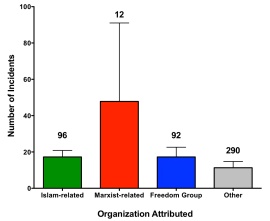
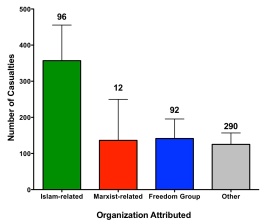
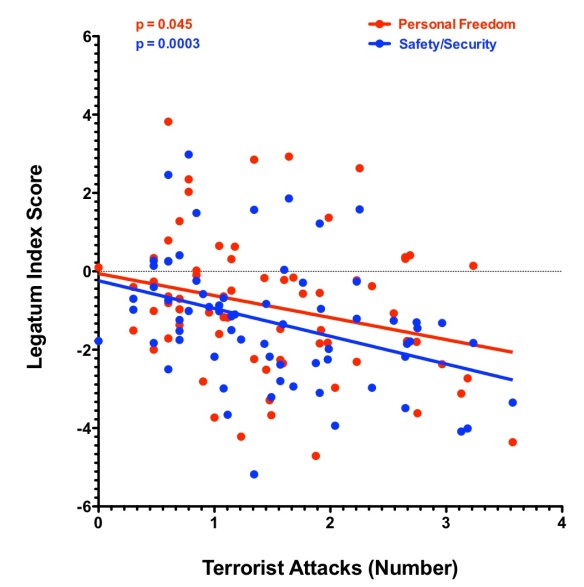
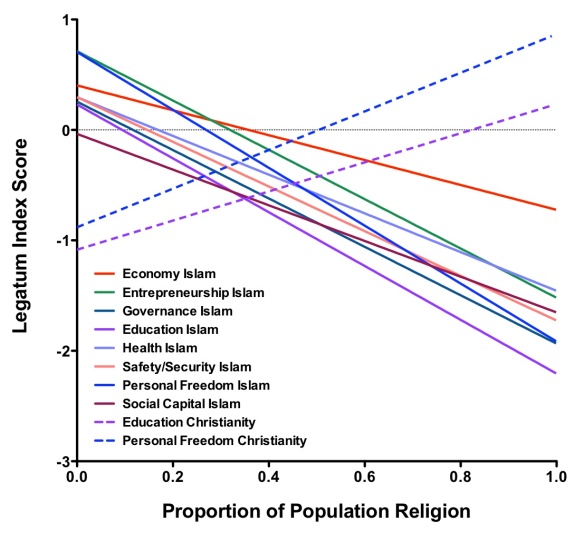
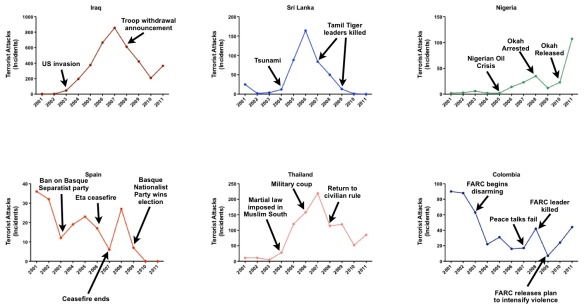
Leave a comment